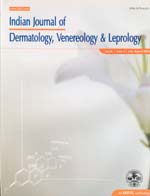
|
Indian Journal of Dermatology, Venereology and Leprology
Medknow Publications on behalf of The Indian Association of Dermatologists, Venereologists and Leprologists (IADVL)
ISSN: 0378-6323
EISSN: 0378-6323
Vol. 78, No. 1, 2012, pp. 68-73
|
 Bioline Code: dv12012
Bioline Code: dv12012
Full paper language: English
Document type: Research Article
Document available free of charge
|
|
|
Indian Journal of Dermatology, Venereology and Leprology, Vol. 78, No. 1, 2012, pp. 68-73
| en |
Segmental vitiligo: A randomized controlled trial to evaluate efficacy and safety of 0.1% tacrolimus ointment vs 0.05% fluticasone propionate cream
Kathuria, Sushruta; Khaitan, Binod K.; Ramam, M & Sharma, Vinod K.
Abstract
Background: Segmental vitiligo is a small subset of vitiligo which responds very well to surgical therapy, but the role of medical treatment is not very well defined.
Aim: To compare the efficacy and safety of 0.1% tacrolimus ointment versus 0.05% fluticasone propionate cream in patients of segmental vitiligo.
Methods: A randomized control trial was conducted in a tertiary care hospital on 60 consecutive patients with segmental vitiligo. Patients with segmental vitiligo exclusively or along with focal vitiligo, untreated or had not taken any topical treatment in previous 1 month or systemic treatment in previous 2 months, from May 2005 to January 2007, were block randomized into two groups. Children <5 years, pregnant and lactating women, and patients with known hypersensitivity to either drug and with associated multiple lesions of vitiligo were excluded. Group A (n = 29) patients were treated with tacrolimus 0.1% ointment twice daily and group B (n = 31) patients were treated with 0.05% of fluticasone cream once daily for 6 months. Response and side effects were recorded clinically and by photographic comparison.
Results: Nineteen patients treated with tacrolimus and 21 patients treated with fluticasone completed the treatment with median repigmentation of 15% and 5%, respectively, at 6 months (P = 0.38). Transient side effects limited to the application site were observed.
Conclusions: Both tacrolimus and fluticasone propionate produce variable but overall unsatisfactory repigmentation in segmental vitiligo.
Keywords
Fluticasone propionate, segmental vitiligo, tacrolimus
|
| |
© Copyright 2012 Indian Journal of Dermatology, Venereology, and Leprology.
Alternative site location: http://www.ijdvl.com
|
|
